As part of your equine management practices to create a healthy living environment for your horses in wet months, many farm owners will create a dry lot. Also known as a sacrifice area, these smaller outdoor turnout areas are designed to be safe and comfortable places for horses to enjoy some movement and socialization when grass turnout isn’t available to them.
Because the paddock is a heavy use area that receives lots of hoof traffic and needs to be usable year round, extra steps must be taken to deal with mud that inevitably comes without any steps for prevention. The best solution is to install a cellular confinement system like Lighthoof. This can frequently go over your existing paddock surface. However, there are many traditional footing materials for use in dry lots. Read on to learn about the pros and cons of each type.
Here is a general overview of all the choices that are available to you and the benefits and precautions you will face with each option.
Wood Paddock Footing Products
There are many types of wood products available which are being used as footings for horse paddocks. This is typically a lower cost option on the spectrum of footings, but requires some caution and has a few downsides.Hogfuel
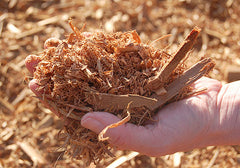 Hogfuel is made by chipping waste-wood products in a wood processor called a “hogger.” This material is often cheap to obtain and varies in quality and composition quite a bit. Hogfuel is commonly used to remediate mud on cow farms due to its relatively low cost. It’s typically a very comfortable material for horses to lay, walk, and urinate on. It does a great job of filling and absorbing muddy spots. However, because it’s absorbent and holds moisture like a sponge, it can harbor bacteria and quickly breaks down into more mud, requiring it to be scraped out, disposed of, and replaced almost yearly. Even still, it is a popular option due to its price and effectiveness, even if it is not a particularly long-lasting solution.
Hogfuel is made by chipping waste-wood products in a wood processor called a “hogger.” This material is often cheap to obtain and varies in quality and composition quite a bit. Hogfuel is commonly used to remediate mud on cow farms due to its relatively low cost. It’s typically a very comfortable material for horses to lay, walk, and urinate on. It does a great job of filling and absorbing muddy spots. However, because it’s absorbent and holds moisture like a sponge, it can harbor bacteria and quickly breaks down into more mud, requiring it to be scraped out, disposed of, and replaced almost yearly. Even still, it is a popular option due to its price and effectiveness, even if it is not a particularly long-lasting solution.
Wood Chips
 Wood chips can often be found for free as a result of the tree trimming industry. If you see a tree trimmer working in your area, you can often stop and leave your contact information as a dump site for the chipped wood. This material makes good pathways and landscaping fill. However, we don’t recommend it for paddocks because it can often have sharp branches, strong scents/oils, or poisonous tasty-looking leaves. If you plan on using this material near or in horse areas be sure to find out what type of tree was being chipped because some trees are very toxic to horses. Common toxic trees include yew, red maple, all cherry trees, all plum trees, oleander, walnut, and oak.
Wood chips can often be found for free as a result of the tree trimming industry. If you see a tree trimmer working in your area, you can often stop and leave your contact information as a dump site for the chipped wood. This material makes good pathways and landscaping fill. However, we don’t recommend it for paddocks because it can often have sharp branches, strong scents/oils, or poisonous tasty-looking leaves. If you plan on using this material near or in horse areas be sure to find out what type of tree was being chipped because some trees are very toxic to horses. Common toxic trees include yew, red maple, all cherry trees, all plum trees, oleander, walnut, and oak.
Bedding / Sawdust
 Sawdust, shavings, and bedding are all better options for indoor horse areas rather than outdoor ones. The benefit of wood products designed as horse bedding is that you know they are safe for keeping horses on and work tremendously well to absorb moisture and neutralize urine odors. However, in an outdoor area these absorbent wood products get saturated quickly and become a mushy mess. Better to use them in the stalls and find an all-weather footing for your outdoor areas.
Sawdust, shavings, and bedding are all better options for indoor horse areas rather than outdoor ones. The benefit of wood products designed as horse bedding is that you know they are safe for keeping horses on and work tremendously well to absorb moisture and neutralize urine odors. However, in an outdoor area these absorbent wood products get saturated quickly and become a mushy mess. Better to use them in the stalls and find an all-weather footing for your outdoor areas.
Rock Paddock Footing Products
Rock products, also known as sand and gravel, are a great choice for paddock footing because they are extremely slow to break down, don’t hold moisture or bacteria, and can be supported for a stronger base. This is typically a more expensive footing option, but the initial investment will last longer if properly installed. There are also many types of rock products available. They vary by geographic location and range from mostly unsuitable to ideal for horses.
Coarse Rock
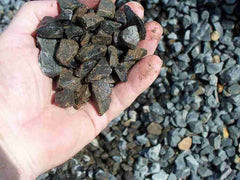 Course angular rock is often found as a base, or as the entire footing material in horse paddocks and gate areas. This type of rock typically has particles that are about 1-2” in diameter and fairly uniform in size. It’s made in a quarry by crushing larger rocks into smaller ones. This rock, once compacted, is fairly hard to damage and drains well. The downside is that it’s not very comfortable for horses to stand or lay on and can be difficult to muck off of because the rocks don’t fall through the fork tines. For these reasons, the most common use for this rock is as a base, usually 3-8” thick, topped with another 4-6” of a finer gravel.
Course angular rock is often found as a base, or as the entire footing material in horse paddocks and gate areas. This type of rock typically has particles that are about 1-2” in diameter and fairly uniform in size. It’s made in a quarry by crushing larger rocks into smaller ones. This rock, once compacted, is fairly hard to damage and drains well. The downside is that it’s not very comfortable for horses to stand or lay on and can be difficult to muck off of because the rocks don’t fall through the fork tines. For these reasons, the most common use for this rock is as a base, usually 3-8” thick, topped with another 4-6” of a finer gravel.
Gravel
 Many kinds of fine gravel are available and most make excellent footing for high traffic horse areas such as paddocks, pathways, and gate areas. Different regions offer different materials, some of them have specific names or numbers, but the main variations are these:
Many kinds of fine gravel are available and most make excellent footing for high traffic horse areas such as paddocks, pathways, and gate areas. Different regions offer different materials, some of them have specific names or numbers, but the main variations are these:
- Particle Size
- Particle Shape
- Particle Uniformity
For gravel, particle size is usually described by the approximate diameter of the largest particle. For example, a ¾” crushed rock has pieces in it that are no larger than ¾” in diameter. If you would like to avoid hoof bruising and discomfort when laying down, choose a maximum particle size that is around ½” or smaller. Be aware that if your horses are barefoot, fine gravel particles can become lodged in the white line area of your horses hoof and, if not removed on a regular basis, can cause flaring, splitting or even abscess. It’s best to pick your horses’ hooves daily or weekly even if you are not riding them. Particle shape is important as it is the key to the stability of your gravel. An angular shape will stay where you put it and provide traction to your horses, whereas a rounded shape will never become firm enough to create a sturdy base and horses will sink or slip in it. Shape is defined by how the gravel is created. If it was created naturally, in a river bed or on a beach for example, it would tend to have rounder particles. If it was man-made in a quarry by crushing bigger rocks into smaller rocks, it would be angular in particle shape. Angular gravel is often referred to as crushed rock and rounded gravel can be found as pea gravel or drainage rock.

Pea Gravel, an example of round rock.
Pea gravel is often praised for its softness on unshod hooves and many people feel that it helps keep bare hooves rounded and filed. As a paddock footing, it has some challenges though. It’s extremely unstable and if it’s not enclosed in a small area with high edges it quickly migrates downhill or spreads out. If it’s placed in a thin layer over a hard surface, it can be dangerously slippery. If it is deep, then the horse’s feet sink in and the hoof is bearing weight at an angle, putting stress on tendons. It drains very well, but water will need some place to go once it drains through or it will pool under the pea gravel and create pea soup! Angular crushed rock is what we recommend for use with Lighthoof mud management panels. It creates a firm clean surface that, when supported by the Lighthoof panels, is long lasting, safe, and easy to maintain.
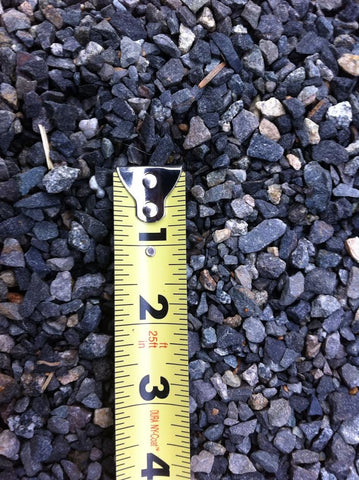
Angular Crushed Rock, very stable and suitable for paddocks.
Particle uniformity refers to the mix of particle sizes within the blend. A “minus” gravel has fines (very small particles) in it which fill the void space between the larger pieces. This makes for a very stable, smooth surface. This effect can also be achieved by mixing sand in with your gravel. A “washed” or “clean” gravel has been sifted and washed to remove the fines. This creates gravel that has more void space which will drain a little more quickly until the gaps fill with something else, such as horsehair, hay, or dust. For this reason, we usually recommend the “minus” gravel because the enhanced stability outweighs the temporary improved porosity when it comes to mud prevention in heavy use horse areas. When selecting gravel footing for your paddocks be sure to ask about the particle size, shape, and uniformity and, if possible, visit the quarry or get a sample of the gravel to take a closer look. Then you will be able to see what’s going on at the particle level and know how it will perform in your paddocks as footing.
Sand
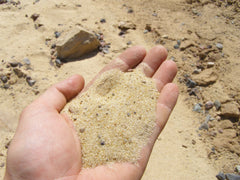 Sand is a much debated choice for horse paddocks. Many people fear using sand because they are worried about sand colic, a dangerous condition that results from the buildup of ingested sand or dirt particles in the horse’s gut. This is indeed something to be careful of but can easily be avoided with careful management. It’s important not to feed horses directly on sand. Always place hay in an enclosed feeder or feed them in another area, for example, a stall that is kept free of sand. A good way to test if your horse is getting a buildup of sand in his gut is to pick up a manure ball with a clear plastic glove on. Invert the glove when you take it off, fill it with water and tie the top. Shake it and squish it to fully dissolve the manure in the water, and then hang it by the top with the fingers pointing down. In a few minutes, sand will settle into the bottom of the finger tips. If you have more than a teaspoon total, consider talking to your vet and/or feeding a sand clearing supplement such as psyllium. But sand colic isn’t a good reason to avoid using sand as a paddock footing; you just have to be careful that your horse isn’t ingesting large amounts of it. In fact, letting a horse graze on thin pastures with sandy soil can be just as harmful. Sand can have many benefits as a footing material. It’s very comfortable for horses to lay, roll and pee in and it’s super easy to keep clean - like cleaning a little box! In fact, horses enjoy it so much that on many Lighthoof installations (where the main footing material is ½” minus crushed rock) we add a small patch of sand for them to roll and pee in.
Sand is a much debated choice for horse paddocks. Many people fear using sand because they are worried about sand colic, a dangerous condition that results from the buildup of ingested sand or dirt particles in the horse’s gut. This is indeed something to be careful of but can easily be avoided with careful management. It’s important not to feed horses directly on sand. Always place hay in an enclosed feeder or feed them in another area, for example, a stall that is kept free of sand. A good way to test if your horse is getting a buildup of sand in his gut is to pick up a manure ball with a clear plastic glove on. Invert the glove when you take it off, fill it with water and tie the top. Shake it and squish it to fully dissolve the manure in the water, and then hang it by the top with the fingers pointing down. In a few minutes, sand will settle into the bottom of the finger tips. If you have more than a teaspoon total, consider talking to your vet and/or feeding a sand clearing supplement such as psyllium. But sand colic isn’t a good reason to avoid using sand as a paddock footing; you just have to be careful that your horse isn’t ingesting large amounts of it. In fact, letting a horse graze on thin pastures with sandy soil can be just as harmful. Sand can have many benefits as a footing material. It’s very comfortable for horses to lay, roll and pee in and it’s super easy to keep clean - like cleaning a little box! In fact, horses enjoy it so much that on many Lighthoof installations (where the main footing material is ½” minus crushed rock) we add a small patch of sand for them to roll and pee in.
Man-made Paddock Footing Products
Manufactured products can be a good way to deal with mud in horse paddocks. In many cases, farm owners have gotten creative with products intended for other industries or uses, but there are also new solutions designed specifically for paddock mud management.
Lighthoof Panels
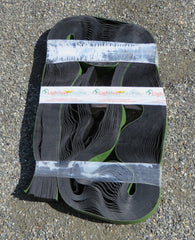 Lighthoof is a flexible plastic material that holds gravel in connected fist-sized cells to give better support to the footing. This stops hooves from churning up the footing with the ground below it and prevents mud from forming.
Lighthoof is a flexible plastic material that holds gravel in connected fist-sized cells to give better support to the footing. This stops hooves from churning up the footing with the ground below it and prevents mud from forming.
Lighthoof requires less footing to achieve stability and creates a permanent solution when paired with angular crushed gravel. It’s easy to install, even over uneven or steep terrain, and is gentle and safe for horses. Learn more about how Lighthoof works. There are also hard plastic grids on the market that provide a different solution to the problem. They go over the crushed rock to distribute the horse’s weight and can work very well in situations where the ground underneath is stable enough to support them and prevent them from moving and coming apart at the seams.
Arena Footing
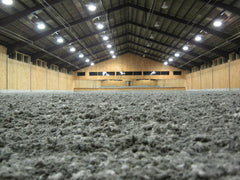 People frequently ask me if they can or should use manufactured arena footing products as their paddock footing. Typically the answer is no, for several reasons. Arena footing products such as crumb rubber, fiber or textile shreds, or other blended materials, are designed to fulfill a certain purpose in the arena. Usually that purpose is shock absorption and/or dust remediation. Besides being terribly expensive, these products aren’t really suitable for paddock footing. Unsupervised horses run the risk of ingesting the material, which could be very harmful. Also, it will get into your manure pile which will hinder the breakdown of manure whether you are dealing with waste onsite or having it removed.
People frequently ask me if they can or should use manufactured arena footing products as their paddock footing. Typically the answer is no, for several reasons. Arena footing products such as crumb rubber, fiber or textile shreds, or other blended materials, are designed to fulfill a certain purpose in the arena. Usually that purpose is shock absorption and/or dust remediation. Besides being terribly expensive, these products aren’t really suitable for paddock footing. Unsupervised horses run the risk of ingesting the material, which could be very harmful. Also, it will get into your manure pile which will hinder the breakdown of manure whether you are dealing with waste onsite or having it removed.
Rubber Mats
 Rubber stall mats can be a good solution for areas of your paddock that need a smooth, impervious, easy to clean surface. They typically run about $30-40 for a 4’x6’ mat and can be stuck down in front of stall doors, under feeders, or anywhere you need them. The cost prohibits them from being used across the whole paddock, but they can be useful in small areas and they are mobile and reusable. Be careful though, because rubber mats can be very slippery when wet. Keep a close eye on the situation to make sure people or horses don’t injure themselves in the rain or near a water trough. Some mats have a rough texture on one side and a smooth texture on the other. Play with which side is up to balance slipperiness with ease of sweeping.
Rubber stall mats can be a good solution for areas of your paddock that need a smooth, impervious, easy to clean surface. They typically run about $30-40 for a 4’x6’ mat and can be stuck down in front of stall doors, under feeders, or anywhere you need them. The cost prohibits them from being used across the whole paddock, but they can be useful in small areas and they are mobile and reusable. Be careful though, because rubber mats can be very slippery when wet. Keep a close eye on the situation to make sure people or horses don’t injure themselves in the rain or near a water trough. Some mats have a rough texture on one side and a smooth texture on the other. Play with which side is up to balance slipperiness with ease of sweeping.
Carpet Remnants & Conveyor Belting
 I’ve heard many stories of people using used scrap carpet or discarded conveyor belting much like rubber mats in their paddocks. Some have even laid it across their entire paddocks to create a surface that is protected from mud oozing up and is sturdy enough for some hoof traffic. The only caution is to ensure that horses don’t get tripped up on the edges of these materials and keep an eye out for ingestion or allergic reactions. Often these discarded products can be picked up for free, so if they don’t last forever, no biggie!
I’ve heard many stories of people using used scrap carpet or discarded conveyor belting much like rubber mats in their paddocks. Some have even laid it across their entire paddocks to create a surface that is protected from mud oozing up and is sturdy enough for some hoof traffic. The only caution is to ensure that horses don’t get tripped up on the edges of these materials and keep an eye out for ingestion or allergic reactions. Often these discarded products can be picked up for free, so if they don’t last forever, no biggie!
As you can see, there are many pros and cons to the different footing options and ultimately your decision will be based on cost, availability, and your preferred farm maintenance routine. There’s no doubt, however, that installing and maintaining a footing material of some kind in your paddocks will help manage mud and create a healthier, safer outdoor living environment for your horse.
Do you have a specific paddock footing question? We would be happy to answer it! Simply leave it in the comments below or contact us.
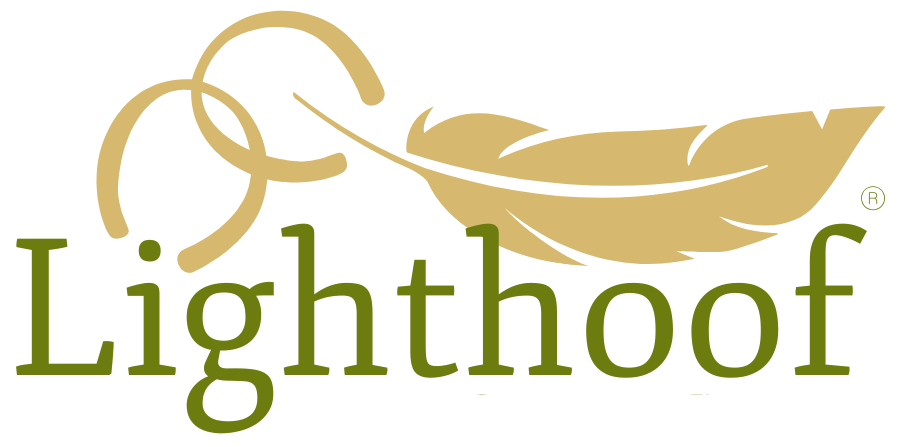
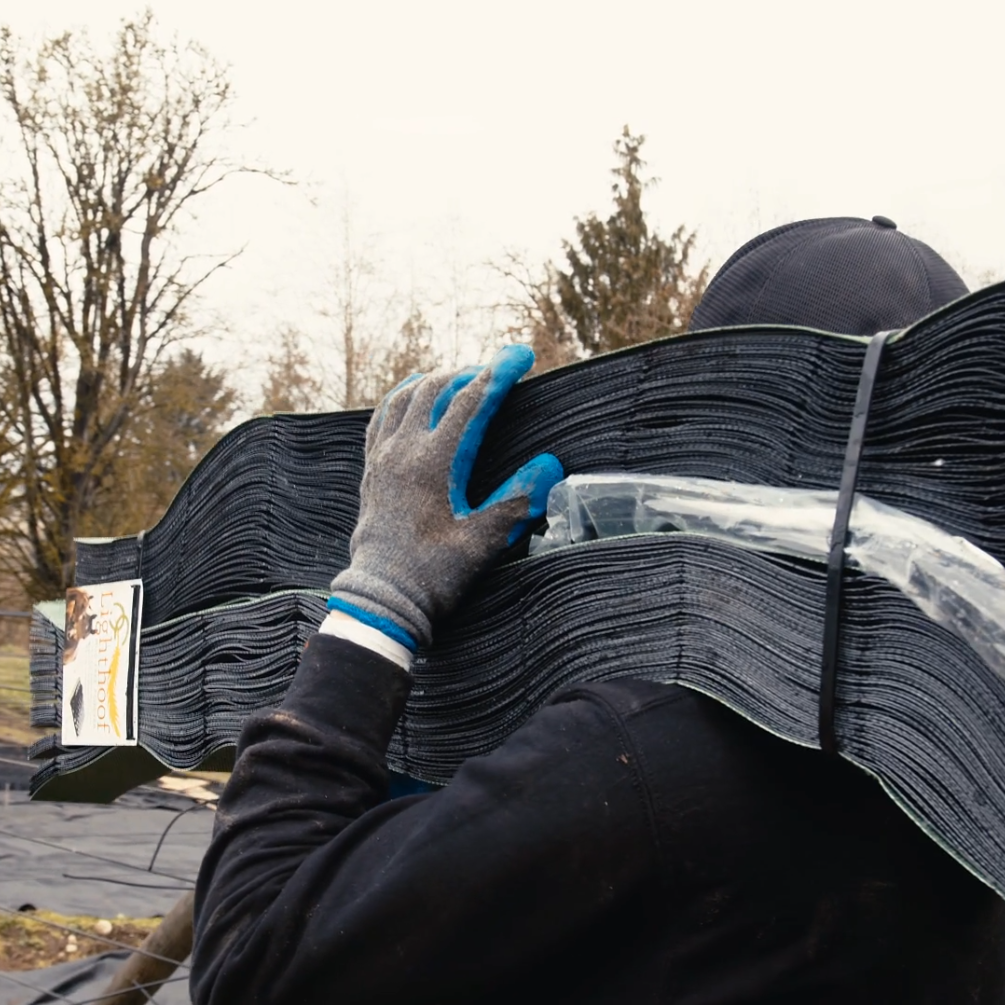

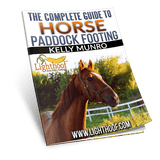
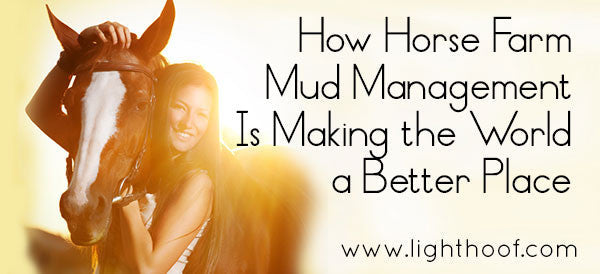
Leave a comment
This site is protected by hCaptcha and the hCaptcha Privacy Policy and Terms of Service apply.